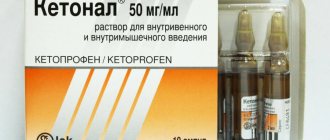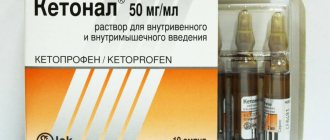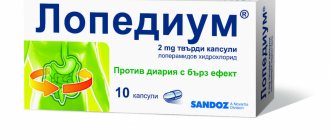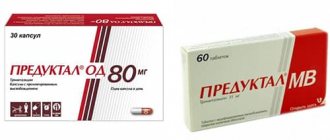Ketonal 50 mg No. 25 capsules
Ketonal 50 mg No. 25 capsules
Trade name Ketonal® International nonproprietary name Ketoprofen Dosage form Capsules 50 mg Composition One capsule contains the active substance - ketoprofen 50 mg, excipients: lactose monohydrate, magnesium stearate, colloidal anhydrous silicon dioxide, capsule shell composition: gelatin, titanium dioxide (E171), blue patent (E131). Description Hard gelatin opaque capsules, the body of the capsule is white, the lid is blue, the contents are a powder or mass in the form of a yellowish-white plug. Pharmacotherapeutic group Non-steroidal anti-inflammatory drugs. Propionic acid derivatives. ATC code M01AE03 Pharmacological properties Pharmacokinetics Ketoprofen is rapidly absorbed from the gastrointestinal tract. Bioavailability after oral administration of 50 mg of ketoprofen is 90% and increases consistently with increasing dose. Food intake does not affect the overall bioavailability (AUC) of ketoprofen, but reduces the rate of absorption. Ketoprofen is 99% bound to blood plasma proteins, mainly to the albumin fraction. The volume of distribution is 0.1-0.2 l/kg. After oral administration of ketoprofen in capsule form, peak plasma concentration is achieved after 1 hour and 22 minutes. In synovial fluid, the concentration of ketoprofen reaches 50% of the plasma concentration (1.5 μg/ml); Ketoprofen is excreted from the synovial fluid slowly - within 24 hours. It is metabolized in the liver, where it is conjugated with glucuronic acid. About 75% of ketoprofen is excreted in the urine, mainly in the form of a conjugate with glucuronic acid. Less than 10% is excreted unchanged in the feces. Ketoprofen does not accumulate in tissues. The half-life of ketoprofen reaches 2 hours. In patients with renal failure, ketoprofen is eliminated more slowly and its half-life is extended by 1 hour. They also have reduced clearance of ketoprofen. In case of severe renal failure, a dose reduction is required. In patients with liver failure, the concentration of ketoprofen in the blood plasma is increased approximately 2 times, which requires the administration of the lowest possible daily dose.
Pharmacodynamics Ketonal® capsules have anti-inflammatory, analgesic and antipyretic effects. The mechanism of action is associated with inhibition of the biosynthesis of prostaglandins and leukotrienes by suppressing the activity of the enzyme cyclooxygenase (cyclooxygenase-1 and cyclooxygenase-2), which catalyzes the synthesis of prostaglandins from arachidonic acid. Ketoprofen stabilizes lysosome membranes and has anti-bradykinin activity. Indications for use Rheumatic diseases: - rheumatoid arthritis - seronegative spondyloarthritis (ankylosing spondylitis, reactive arthritis) - gout, pseudogout - osteoarthritis - extra-articular rheumatism (tendinitis, bursitis, capsulitis of the shoulder joint) Pain syndrome: - post-traumatic - postoperative - algodismenorrhea - pain for bone metastases in patients with cancer. Method of administration and dosage Ketonal® capsules are taken without chewing, with a sufficient amount of water or milk (at least 100 ml), during meals or immediately after meals. Capsules 50 mg: prescribed for adults, 1 capsule in the morning, lunch and evening. The recommended dose for the treatment of rheumatoid arthritis is 1 capsule every 6 hours. The maximum daily dose is 200 mg. To avoid unwanted side effects, the patient can take antacids simultaneously with Ketonal®. The duration of treatment is determined by the doctor. In patients with mild renal failure with creatinine clearance below 20 ml/min and with chronic liver disease (with reduced serum albumin levels), the dose of ketoprofen should be reduced. Side effects When assessing the frequency of occurrence of various adverse reactions, the following gradations were used: “very often” – 10%, “often” – from 1% to 10%, “infrequently” – from 0.1% to 1%, “rarely” – from 0.01% to 0.1%, “very rarely” – 0.01%. Often: - dyspeptic symptoms, loss of appetite, nausea, vomiting, flatulence, abdominal pain, constipation Uncommon: - diarrhea, gastritis - headache, dizziness, drowsiness - skin rash Rarely: - hemorrhagic anemia, leukopenia - depression, insomnia, nervousness, paresthesia - blurred vision - tinnitus - stomatitis, gastric and duodenal ulcers - hepatitis, increased levels of transaminases and bilirubin - weight gain - anaphylactic shock - bronchospasm, attack of bronchial asthma Very rare: - exacerbation of colitis and Crohn's disease, gastrointestinal bleeding - impaired liver function - acute renal failure, tubulointerstitial nephritis - hypernatremia, hyperkalemia - agranulocytosis, thrombocytopenia - seizures - heart failure - arterial hypertension - rhinitis - photosensitivity, Quincke's edema, bullous rash, including Stevens-Johnson syndrome, toxic epidermal necrolysis Contraindications - individual hypersensitivity to ketoprofen, aspirin or other non-steroidal anti-inflammatory drug (history of asthma, bronchospasm, urticaria or rhinitis associated with taking acetylsalicylic acid) - severe heart failure - diseases of the gastrointestinal tract in the acute phase (gastritis, gastric ulcer, indication in the anamnesis of gastrointestinal bleeding, formation or perforation of ulcers) - bleeding (gastrointestinal, cerebrovascular or other active bleeding) - tendency to bleeding - severe dysfunction of the liver or kidneys - blood disorders (leukopenia, thrombocytopenia, hemocoagulation disorders) - bronchial asthma, rhinitis - pregnancy and lactation - childhood and adolescence under 18 years of age Drug interactions Ketonal should not be used in combination with other non-steroidal anti-inflammatory drugs and salicylates. When combined with corticosteroids, the risk of ulceration and gastrointestinal bleeding increases. Antioagulants (heparin and warfarin) and platelet aggregation inhibitors (ie, ticlopidine, clopidogrel) increase the risk of bleeding. If coadministration is unavoidable, close monitoring of the patient is necessary. Ketonal reduces the effectiveness of antihypertensive and diuretic drugs. The risk of developing renal failure is greater in patients who take diuretics, antihypertensives, or ACE inhibitors concomitantly with nonsteroidal anti-inflammatory drugs. Potassium supplements, potassium-sparing diuretics, ACE inhibitors, heparins (low molecular weight or unfractionated), cyclosporine, tacrolimus and trimethoprim, when used simultaneously with non-steroidal anti-inflammatory drugs, may contribute to the occurrence of hyperkalemia. Ketonal enhances the effect of oral hypoglycemic drugs and some anticonvulsants (phenytoin). Ketonal, like other non-steroidal anti-inflammatory drugs, reduces the excretion and thereby increases the toxicity of cardiac glycosides, lithium, cyclosporine and methotrexate. Nonsteroidal anti-inflammatory drugs may reduce the effectiveness of mifepristone. Taking non-steroidal anti-inflammatory drugs should be started no earlier than 8-12 days after stopping mifepristone. When cyclosporine is used simultaneously with ketonal, the risk of toxic kidney damage increases. Special instructions Avoid simultaneous use of Ketonal with other non-steroidal anti-inflammatory drugs, including selective COX-2 inhibitors. The drug should be prescribed with extreme caution to patients with a history of gastrointestinal diseases (bleeding and perforation can develop suddenly without previous symptoms). Caution should also be exercised in patients taking medications that may increase the risk of ulceration or bleeding, such as oral corticosteroids, anticoagulants (eg warfarin), selective serotonin reuptake inhibitors, or antiplatelet agents (including acetylsalicylic acid). The risk of gastrointestinal bleeding and the formation or perforation of ulcers increases with increasing doses of nonsteroidal anti-inflammatory drugs. In such cases, combination therapy with drugs that have a protective effect on the gastrointestinal tract (for example, misoprostol or proton pump inhibitors) should be considered. Patients with diseases of the gastrointestinal tract (especially the elderly) should report any abdominal manifestations to their doctor. If gastrointestinal bleeding or gastrointestinal ulceration occurs, treatment should be stopped immediately. Careful monitoring of patients with arterial hypertension and/or congestive heart failure is necessary, as there are reports of the development or intensification of fluid retention in the body during therapy with ketoprofen. During treatment with ketoprofen, monitoring of blood pressure is recommended, especially in patients with cardiovascular diseases. Patients with uncontrolled arterial hypertension, acute and severe chronic heart failure, coronary artery disease, peripheral artery disease and/or cerebrovascular disease should be treated with ketoprofen with caution. The use of some non-steroidal anti-inflammatory drugs may be associated with a risk of arterial thrombosis (myocardial infarction, stroke). There is insufficient data to exclude such a risk for ketoprofen. Patients with asthma, chronic rhinitis, chronic sinusitis and/or nasal polyposis may experience allergic reactions more often than other patients. Caution should also be exercised in patients with hemostasis disorders, hemophilia, von Willebrand-Jurgens disease, severe thrombocytopenia, renal or liver failure, and in those patients taking anticoagulants (coumarin and heparin derivatives, especially low molecular weight heparins). At the beginning of treatment, careful monitoring of renal function should be carried out in patients with heart failure, cirrhosis and nephrosis, in patients undergoing diuretic therapy, in patients with chronic renal failure, especially if the patient is elderly. In such patients, ketoprofen may cause a decrease in renal blood flow as a result of prostaglandin inhibition and lead to renal decompensation. If visual disturbances are observed during treatment, treatment should be discontinued. Treatment with ketoprofen should be discontinued before radical surgery. Taking ketoprofen may impair female fertility and is not recommended for women who want to become pregnant. This medicinal product contains ethanol 12.3% (w/w). Each 2 ml dose contains 0.2 g of ethanol. The drug should be prescribed with caution to elderly people. Long courses of therapy with non-steroidal anti-inflammatory drugs, including ketoprofen, require monitoring of hematological parameters, liver and kidney function, especially in elderly patients. Features of the effect of the drug on the ability to drive a vehicle or operate potentially dangerous mechanisms If dizziness, spatial disorientation, drowsiness, blurred vision or convulsions occur, you should not drive or operate potentially dangerous mechanisms. Overdose Symptoms: nausea, vomiting, abdominal pain, vomiting blood, black stools, impaired consciousness, respiratory depression, convulsions, impaired renal function and renal failure. Treatment: symptomatic, there is no specific antidote. Gastric lavage and the use of activated carbon are indicated. The effects of ketoprofen on the gastrointestinal tract can be weakened with the help of H2 blockers, proton pump inhibitors and prostaglandins. Release form: 25 capsules in amber glass bottles, sealed with plastic caps with first opening control. 1 bottle, along with instructions for use in the state and Russian languages, is placed in a cardboard pack. Storage conditions Store at a temperature not exceeding 25? C. Keep out of the reach of children! Shelf life: 5 years The drug should not be used after the expiration date indicated on the package. Conditions for dispensing from pharmacies By prescription
Ketonal capsules 50 mg cor x25
Trade name: Ketonal International name: Ketoprofen
Release form: 50 mg capsules (dark glass bottles)
Composition: ketoprofen 50 mg
Pharmacological group: NSAID (non-steroidal anti-inflammatory drug)
Pharmacological group according to ATK: M01AE03 (Ketoprofen)
Pharmacological action: antiplatelet, antipyretic, NSAID, anti-inflammatory, analgesic,
Description: The capsules are opaque, with a white body and a blue cap. Forte tablets, light blue coated, round, biconvex. Retard tablets are white, round, biconvex.
Ingredients: 1 capsule contains: ketoprofen - 50 mg, Excipients: vegetable oil, hydrogenated soybean oil, beeswax, gelatin, glycerol, sorbitol, titanium dioxide, sodium ethyl p-hydroxybenzoate, sodium propyl p-hydroxybenzoate.
1 tablet forte contains: ketoprofen - 100 mg, Excipients: magnesium stearate, colloidal silicon dioxide, povidone, starch, purified talc, lactose sieve 200, hydroxypropyl methylcellulose, polyethylene glycol 400, blue indigotine dye (E132), titanium dioxide, carnauba wax.
1 retard tablet contains: ketoprofen - 150 mg, Excipients: magnesium stearate, colloidal silicon dioxide, povidone, microcrystalline cellulose, hydroxypropyl methylcellulose.
Indications: For systemic use - symptomatic treatment of painful inflammatory processes of various origins (including postoperative and post-traumatic pain, sciatica, myalgia, radiculitis, bruises and muscle strains, rheumatoid arthritis, ankylosing spondylitis, osteoarthritis, acute attack of gout, tenosynovitis, bursitis ), - symptomatic treatment of acute pain syndrome in inflammatory diseases of the musculoskeletal system (only for intramuscular administration).
Dosage regimen: For adults, the drug is prescribed 1-2 capsules 2-3 times a day, or 1 tablet. forte 2-3 times a day, or 1 tablet. retard 1-2 times/day. Capsules and tablets should be taken during or immediately after meals, without chewing, with plenty of water. The maximum daily dose is 300 mg.
Contraindications: - gastrointestinal diseases in the acute phase, - severe liver dysfunction, - severe renal dysfunction, - blood disorders (leukopenia, thrombocytopenia, blood coagulation disorders), - III trimester of pregnancy, - lactation (breastfeeding), - children under 15 years of age, - hemorrhoids and proctitis (for suppositories), - hypersensitivity to ketoprofen, acetylsalicylic acid or other NSAIDs (history of bronchospasm, urticaria and rhinitis caused by taking acetylsalicylic acid).
Side effects: From the digestive system: nausea, flatulence, abdominal pain, diarrhea, vomiting, rarely - bleeding from the gastrointestinal tract. From the side of the central nervous system: rarely - headache, dizziness, drowsiness, tinnitus. Allergic reactions: rarely - itching, urticaria. Other: transient dysuria, asthenia.
Overdose Currently, no cases of overdose of the drug Ketonal have been reported. In case of accidental overdose, symptomatic therapy is indicated. There is no specific antidote.
Pharmacodynamics: NSAID, propionic acid derivative. It has analgesic, anti-inflammatory and antipyretic effects. The mechanism of action is associated with inhibition of prostaglandin synthesis at the level of cyclooxygenase. In addition, ketoprofen inhibits lipoxygenase, has antibradykinin activity, stabilizes lysosomal membranes, and causes significant inhibition of neutrophil activity in patients with rheumatoid arthritis. The anti-inflammatory effect occurs by the end of 1 week of use. The pronounced analgesic effect of ketoprofen is due to two mechanisms: peripheral (indirectly, through suppression of the activity of COX1 and COX2, which regulate the synthesis of Pg) and central (due to inhibition of prostaglandin synthesis in the central and peripheral nervous system). The lysine salt of ketoprofen has equally pronounced anti-inflammatory, analgesic, and antipyretic effects. Does not have a catabolic effect on articular cartilage.
Pharmacokinetics: Absorption is rapid, bioavailability is more than 90%. Communication with plasma proteins - 99%. TCmax - 1-2 hours after oral administration, 1.4-4 hours - with rectal administration, 15-30 minutes - with parenteral administration. When taking retard tablets, the minimum effective concentration is determined after 45-60 minutes. Css in plasma is achieved 24 hours after the start of regular use. The therapeutic concentration in the synovial fluid lasts 6-8 hours. It does not penetrate the BBB in a significant amount. It is almost completely metabolized in the liver by glucuronidation and has a “first pass” effect through the liver. Excreted by the kidneys (mainly) and intestines (1%). T1/2 - 1.6-1.9 hours. Does not accumulate. Lysine salt of ketoprofen: TCmax after oral administration in the form of granules - 15 minutes, with parenteral administration - 20-30 minutes, with rectal administration - 45-60 minutes. The effective concentration is achieved after 20-30 minutes and persists for 24 hours. Therapeutic concentration in synovial fluid persists for 18-20 hours. Metabolized by microsomal liver enzymes. Excreted by the kidneys, 60-80% - in the form of glucuronide in 24 hours.
Special instructions: Caution should be exercised when using Ketonal simultaneously with acetylsalicylic acid or other NSAIDs, lithium preparations, antihypertensive drugs, diuretics, methotrexate, antidiabetic drugs. During the treatment period, it is prohibited to drink alcohol. Effect on the ability to drive vehicles and operate machinery When using the drug, care should be taken for persons whose activities require rapid psychomotor reactions (driving a car, working with machinery).
Pregnancy and lactation The safety of ketoprofen during pregnancy and lactation has not been studied. The use of Ketonal in the first and second trimesters of pregnancy is possible only when the potential benefit to the mother outweighs the risk to the fetus. The use of Ketonal in the third trimester of pregnancy (especially after 36 weeks) is contraindicated due to the possible effect on the tone of the uterus. If it is necessary to use Ketonal during lactation, the issue of stopping breastfeeding should be decided.
The drug is prescribed with caution in case of impaired liver or kidney function, a history of gastrointestinal diseases, bronchial asthma, rhinitis, urticaria, polyps of the nasal mucosa, heart failure, and in elderly patients.
Interaction: Pharmaceutically incompatible with tramadol solution. Since ketoprofen binds to plasma proteins to a significant extent, the doses of anticoagulants, diphenylhydantoin or sulfur-containing drugs used simultaneously with Ketonal should be reduced.
Storage conditions: The drug should be stored out of the reach of children at a temperature not exceeding 25°C.
Shelf life: The shelf life of film-coated forte tablets, retard tablets, capsules, suppositories is 5 years, solution for injection is 3 years.
Dispensed from pharmacies: Dispensed by prescription.
Drug registration number: P No. 013942/05
Date of registration (re-registration) of the drug: 09/29/2003




